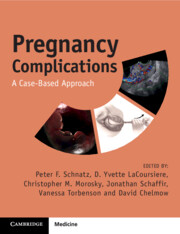Book contents
- Pregnancy Complications
- Pregnancy Complications
- Copyright page
- Contents
- Contributors
- Preface
- Note from the Editor-in-Chief
- Normal Laboratory Values (Conventional Units) []
- Section 1 Antepartum (Early Pregnancy)
- Section 2 Antepartum (Mid-trimester)
- Section 3 Antepartum (Late Pregnancy)
- Case 20 A Patient with Regular Painful Uterine Contractions at 32 Weeks
- Case 21 A 25-Year-Old Presents at 22 Weeks’ Gestation Leaking Clear Fluid
- Case 22 A 40-Year-Old at 34 Weeks’Gestation with Worsening Itching
- Case 23 A 25-Year-Old Presents at 30 Weeks’ Gestation Following a Motor Vehicle Accident
- Case 24 A 20-Year-Old Presents at 34 Weeks’ Gestation with Pruritic Abdominal Rash
- Case 25 A 30-Year-Old Presents at 18 Weeks’ Gestation with Severe Right Back and Flank Pain
- Case 26 A 30-Year-Old at 18 Weeks’ Gestation with Fever, Dysuria, Worsening Flank Pain, and Hydronephrosis
- Case 27 A 35-Year-Old with Abdominal Wall Bulge at 24 Weeks’ Gestation
- Case 28 A 30-Year-Old Presents for a Prenatal Visit at 41 Weeks’ Gestation
- Case 29 A 40-Year-Old Presents at 34 Weeks’ Gestation with Absent Fetal Movement
- Case 30 A 25-Year-Old at 36 Weeks’ Gestation Presents with Severe Bilateral Wrist Pain
- Case 31 A 20-Year-Old Presents at 31 Weeks’ Gestation with Severe Abdominal Pain and Constipation
- Section 4 Antepartum (Medical Complications)
- Section 5 Antepartum (Infectious Complications)
- Section 6 Intrapartum/Delivery
- Section 7 Postpartum
- Section 8 Fetal Complications
- Section 9 Placental Complications
- Section 10 Complications of the Cord, Amnion, and Gravid Uterus
- Section 11 Psychosocial Considerations
- Index
- References
Case 21 - A 25-Year-Old Presents at 22 Weeks’ Gestation Leaking Clear Fluid
from Section 3 - Antepartum (Late Pregnancy)
Published online by Cambridge University Press: 08 April 2025
- Pregnancy Complications
- Pregnancy Complications
- Copyright page
- Contents
- Contributors
- Preface
- Note from the Editor-in-Chief
- Normal Laboratory Values (Conventional Units) []
- Section 1 Antepartum (Early Pregnancy)
- Section 2 Antepartum (Mid-trimester)
- Section 3 Antepartum (Late Pregnancy)
- Case 20 A Patient with Regular Painful Uterine Contractions at 32 Weeks
- Case 21 A 25-Year-Old Presents at 22 Weeks’ Gestation Leaking Clear Fluid
- Case 22 A 40-Year-Old at 34 Weeks’Gestation with Worsening Itching
- Case 23 A 25-Year-Old Presents at 30 Weeks’ Gestation Following a Motor Vehicle Accident
- Case 24 A 20-Year-Old Presents at 34 Weeks’ Gestation with Pruritic Abdominal Rash
- Case 25 A 30-Year-Old Presents at 18 Weeks’ Gestation with Severe Right Back and Flank Pain
- Case 26 A 30-Year-Old at 18 Weeks’ Gestation with Fever, Dysuria, Worsening Flank Pain, and Hydronephrosis
- Case 27 A 35-Year-Old with Abdominal Wall Bulge at 24 Weeks’ Gestation
- Case 28 A 30-Year-Old Presents for a Prenatal Visit at 41 Weeks’ Gestation
- Case 29 A 40-Year-Old Presents at 34 Weeks’ Gestation with Absent Fetal Movement
- Case 30 A 25-Year-Old at 36 Weeks’ Gestation Presents with Severe Bilateral Wrist Pain
- Case 31 A 20-Year-Old Presents at 31 Weeks’ Gestation with Severe Abdominal Pain and Constipation
- Section 4 Antepartum (Medical Complications)
- Section 5 Antepartum (Infectious Complications)
- Section 6 Intrapartum/Delivery
- Section 7 Postpartum
- Section 8 Fetal Complications
- Section 9 Placental Complications
- Section 10 Complications of the Cord, Amnion, and Gravid Uterus
- Section 11 Psychosocial Considerations
- Index
- References
Summary
A patient presents with periviable preterm prelabor rupture of membranes (PPROM) at 22 weeks. Management of patients presenting with periviable PPROM is complex and dependent upon patient desires as well as availability of neonatal care, termination capabilities, and local laws. Initial evaluation after diagnosis of periviable PPROM includes evaluation for preterm labor, intraamniotic infection and placental abruption. In the absence of these scenarios, this patient would be counseled on the maternal and fetal risks of continuing the pregnancy, including but not limited to intraamniotic infection and its potential sequelae including maternal sepsis and death, risk of preterm delivery, and fetal risks such as pulmonary hypoplasia, limb contractures and neonatal death. After being counseled on the pregnancy prognosis, the patient may opt for pregnancy continuation or for pregnancy termination either by dilation and evacuation or labor induction. Antenatal steroids, magnesium sulfate, and short-term tocolytics are recommended in certain patients with periviable PPROM and in most circumstances, patients at 23 0/7 weeks’ gestation or later are candidates for these interventions. Administration of antibiotics to prevent infection or “latency antibiotics” is reasonable as early as 20 0/7 weeks’ gestation.
Keywords
- Type
- Chapter
- Information
- Pregnancy ComplicationsA Case-Based Approach, pp. 65 - 68Publisher: Cambridge University PressPrint publication year: 2025

